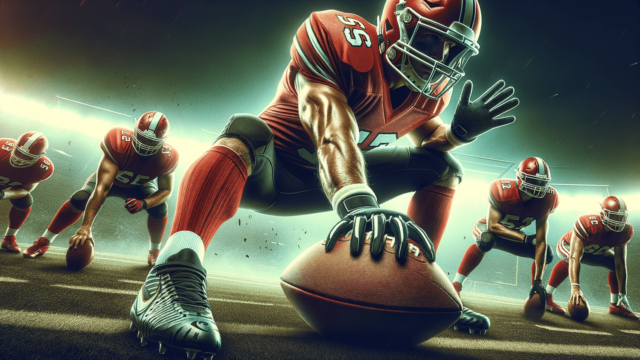
How Far Can the Average Person Throw a Football?
Written by: Football Universe
Last updated:

The average person can throw a football approximately 25 to 30 yards, taking into account both males and females, with varying levels of skill and physical fitness. However, this figure might fluctuate based on factors like arm strength, technique, and prior experience.
Factors Affecting Football Throw Distance
When trying to determine how far the average person can throw a football, various factors come into play, such as:
- Arm strength
- Throwing technique
- Prior experience
- Physical fitness
Average Football Throwing Distance by Gender
Gender plays a significant role in the average throwing distance of a football, with the key difference being:
- Men: On average, men can throw a football between 30 to 35 yards.
- Women: On average, women can throw a football between 20 to 25 yards.
Arm Strength and Technique
Arm strength is pivotal when it comes to throwing a football. A powerful arm will generate more force, allowing the ball to cover greater distances. Additionally, mastering the right technique or throwing motion will drastically improve accuracy and distance.
Prior Experience and Physical Fitness
Individuals with prior football experience are more likely to throw the ball farther, as they have honed their skills and muscle memory. Moreover, those in good physical shape will have an advantage, as stamina, body control, and muscle coordination contribute to improved performance.
Maximizing Football Throwing Distance
If you’re looking to increase your football throwing distance, here are some tips to consider:
- Practice regularly: The more you practice, the better your muscle memory and technique will become.
- Condition your arm: Engage in strength training exercises to strengthen your arm muscles and improve your throwing power.
- Work on your technique: Consult a coach or watch instructional videos to enhance your throwing motion and grip.
- Maintain physical fitness: Regularly work out to optimize your overall fitness levels and ensure your body is prepared for the athletic demands of throwing a football.
Understanding Aerodynamics and Flight Trajectory
An essential aspect of throwing a football is to understand the aerodynamics and how to manipulate the flight trajectory of the ball. To do this, focus on two aspects:
- Spiral: A tight spiral creates less air resistance, enabling the ball to fly farther and more accurately. A spiral throw is achieved by releasing the ball with a slight spin, using the fingers to propel the ball in a corkscrew motion.
- Launch angle: The optimal angle for a football throw is around 45 degrees relative to the ground. This is the angle that generates the farthest throw by achieving the perfect balance between vertical and horizontal motion. To maximize your launch angle, use your hips and shoulders to add additional torque when releasing the ball.
Importance of Proper Footwork
Proper footwork can greatly influence your ability to throw a football far and accurately. Being mindful of your balance, stance, and weight transfer will enhance your throwing performance:
- Balance: Maintain an even distribution of weight on both legs when preparing to throw the ball, and avoid leaning too far forward or backward.
- Stance: Adhere to a comfortable throwing position, ideally with a slight bend in your knees and your feet shoulder-width apart.
- Weight transfer: As you throw, shift your weight from your back foot to your front foot. This supports the release’s power and allows you to cover more ground with your throw.
Equipment and Weather Conditions
The type of football used and the prevailing weather conditions can also influence throwing distance:
- Ball type: Footballs come in various sizes, materials, and air pressures. Using the appropriate ball for your age and skill level can directly affect how far you can throw the ball.
- Weather conditions: Ideal weather conditions for throwing far are cool, calm days. Wind, rain, and humidity can alter a throw’s trajectory and distance, as well as make it more challenging to grip the ball properly.
FAQ Section: Throwing a Football
In this FAQ section, we address common questions that might arise after reading our blog post on how far the average person can throw a football. These brief answers will provide further guidance on improving your throwing game.
What are some specific exercises to improve arm strength for throwing a football?
Focus on exercises that target your primary throwing muscles, such as dumbbell bench presses, tricep extensions, lateral raises, and rows. Incorporate bicep curls and wrist flexion exercises to maintain overall arm strength and balance.
How can I improve my grip on the football for better spirals and accuracy?
Ensure your fingers are evenly spaced on the ball’s laces, with the thumb placed beneath the ball. Maintain a firm yet relaxed grip and use the thumb, index finger, and middle finger to generate the spiral. Practicing consistently helps improve your grip and spiral over time.
What role does body positioning play when attempting to throw a football far?
Body positioning is crucial for a strong, effective throw. Engage your hips and core muscles before releasing the ball, as this generates additional torque and power. Keep your non-throwing shoulder pointed towards your target, and maintain a balanced stance throughout the throw.
How can I effectively train to increase my throwing distance?
Combine regular throwing practice with strength training and conditioning exercises. Work on improving technique, footwork, and launch angle. It may be helpful to consult with a coach or watch instructional videos to learn from experts.
How can I maintain a reliable throwing performance in unpredictable weather conditions?
Practice in a variety of weather situations to become accustomed to different challenges. An effective way to maintain grip in wet conditions is to keep a towel handy to dry your hands and the ball. During windy conditions, adjust your spiral and timing accordingly to overcome air resistance.
Featured Posts
- No pillar pages found.





